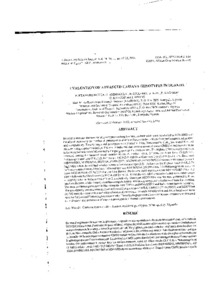| dc.contributor.author | Ntawuruhunga, Pheneas |
| dc.contributor.author | Ssemakula, G.N. |
| dc.contributor.author | Ojulong, H. |
| dc.contributor.author | Bua, A. |
| dc.contributor.author | Ragama, P. |
| dc.contributor.author | Kanobe, C. |
| dc.contributor.author | Whyte, J. |
| dc.date.accessioned | 2019-12-04T11:26:27Z |
| dc.date.available | 2019-12-04T11:26:27Z |
| dc.date.issued | 2006 |
| dc.identifier.citation | Ntawuruhunga, P., Ssemakula, G., Ojulong, H., Bua, A., Ragama, P., Kanobe, C. & Whyte, J. (2006). Evaluation of advanced cassava genotypes in Uganda. African Crop Science Journal, 14(1), I-7. |
| dc.identifier.issn | 1021-9730 |
| dc.identifier.uri | https://hdl.handle.net/20.500.12478/4605 |
| dc.description.abstract | In a bid to increase the number of genotypes reaching farmers, on-farm trials were conducted in 2001/2002 with the aim of increasing the number of genotypes available to farmers to be evaluated for performance, adaptation and acceptability. Twenty improved genotypes were planted in Lira, Nakasongola, Gulu, Kumi and Katakwi districts using augmented design. The results indicated that cassava mosaic disease (CMD) varied from location to location but was more influenced by the genotype than the environment. The highest CMD severity (>4) was recorded among the farmers' local varieties across all environments, followed by Alice local (3.8±O.4) in Nakasongola and Lira (2.8±O.2) districts and 160142 (3.0±0.0) in Kumi and Lira (2.8±O.2) districts. Six clones (MM96/0245, MM96/056 I , 192/2324, MM96/3585, MM96/4589 and MM96/0264) showed resistance (score I for CMD) while the rest had severity scores below the average (2.5). At harvest, the highest yield (60.8±3.7 t ha-') was obtained from Alice local followed by clone MM 96/0561 (59.5±6.6 t ha-') in Nakasongola district and clone MM 96/4614 (52.5±13.2 t ha-') in Lira district. The lowest yield was from clone MM 96/3585 (l0.3±4.2 t ha-') followed by Oko Iyawo (I) 99 (l4.2±4.2 t ha-') in Kumi district. All the varieties tested were either sweet or slightly bitter with the scores of I or 2, respectively. Genotype MH97/296I was the most preferred in Kumi and Lira districts, while it was third in Nakasongoladistrict. All these genotypes also had a sweet taste for cooking. The most preferred genotypes in N akasongola were TME 5 and MM96/53 12 and had a sweet taste for cooking.
The genotype by environment analysis indicated that genotypes TME 5, MM961 1419, 19210427, and MH97/044 (2) UG were the most stable and adapted across all environments while MM96/4614 and Alice local were more specific for Lira and Nakasongola, respectively. These findings provide a basis for recommendations with regard to cultivation and preference of cassava genotypes in different environments. |
| dc.format.extent | 1-7 |
| dc.language.iso | en |
| dc.rights | Other |
| dc.subject | African Cassava Mosaic Virus |
| dc.subject | Cassava |
| dc.subject | Plant Diseases |
| dc.subject | Genotypes |
| dc.title | Evaluation of advanced cassava genotypes in Uganda |
| dc.type | Journal Article |
| dc.description.version | Peer Review |
| cg.contributor.crp | Agriculture for Nutrition and Health |
| cg.contributor.crp | Roots, Tubers and Bananas |
| cg.contributor.affiliation | International Institute of Tropical Agriculture |
| cg.contributor.affiliation | National Agricultural Research Organisation, Uganda |
| cg.coverage.region | Africa |
| cg.coverage.region | East Africa |
| cg.coverage.country | Uganda |
| cg.creator.identifier | Pheneas Ntawuruhunga: 0000-0003-2330-9070 |
| cg.authorship.types | CGIAR and developing country institute |
| cg.iitasubject | Cassava |
| cg.iitasubject | Plant Diseases |
| cg.journal | African Crop Science Journal |
| cg.howpublished | Formally Published |
| cg.accessibilitystatus | Limited Access |
| local.dspaceid | 100924 |
| cg.targetaudience | Scientists |

